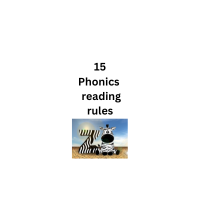The Phonics rules in English

15 phonics rules
Vowels in Syllables:
Vowels can be short (like a in cat) or long (like a in cake). Vowels can also be found in different types of syllables (closed, open, etc.).
Short and Long Vowels:
English vowels can often be pronounced differently in different words based on whether they are short or long, affecting the word’s meaning (bit vs. bite).
Silent E:
The presence of a silent e at the end of a word can change the preceding vowel sound from short to long (mat vs mate).
Consonant Blends and Digraphs:
Consonant blends are groups of two or more consonants with their individual sounds (bl in blue), while digraphs are pairs of letters representing one sound (sh in ship).
Vowel Digraphs:
Vowel digraphs are two vowels together that make a single sound (ai in rain).
R-Controlled Vowels:
When a vowel is followed by the letter r, it often changes the way the vowel is pronounced (ar in car).
Schwa Sound:
The schwa sound is a reduced vowel sound often heard in unstressed syllables (a in sofa)( a in about)( o in havoc)( u in supply)
Soft C and G, Hard C and G:
The letters c and g can have soft sounds (like c in cent or g in giant) and hard sounds (like c in cat or g in go).
Fizzle Rule:
When a one-syllable word ends with a single vowel followed by a single consonant, double the final consonant when adding a suffix( l, f, s, and z: still, staff, bill, jazz, floss).
Ending in K and CK:
Generally, use k at the end of a one-syllable word with long vowel and ck after a short vowel ( beak, seek, break – chick, crack, stick)
J and CH Sound:
J often makes the j sound (jelly) ,(judge) while ch can make the ch sound (chat) or a k sound (chemist).
Drop the E with -ING:
When adding -ing to a word ending in silent e, drop the e (take + ing = taking).
Doubling:
When adding suffixes to words with one syllable or accented final syllable, double the final consonant if the syllable is stressed and ends in a single vowel followed by a single consonant (big + er = bigger).
Plurals:
Add -s or -es for regular plurals (cat to cats, box to boxes).
Y Rules and Exceptions:
When y is a vowel (e.g., cry), it often changes to i when adding a suffix (cry + ing = crying). However, there are exceptions (play + ing = playing).
click hereThe Phonics rules in English
click here The Alphabet names in English
click here The International Phonetic Alphabet symbols for English phonemes
click here About English Alphabet
click here Auditory Phonetics
click here Acoustic Phonetics
click here Articulatory Phonetics
click here English Phonetics
click here About Phonetics